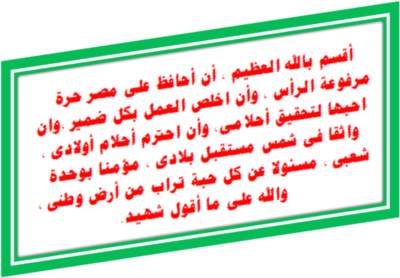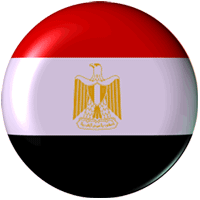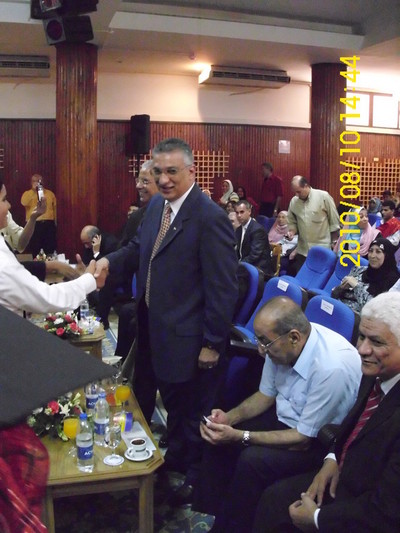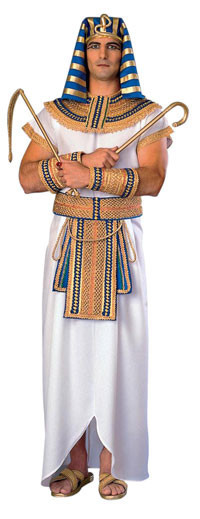Muhammad Ali of Egypt
people named Muhammad Ali, or Mehmet Ali, see Muhammad Ali (disambiguation) and Mehemet Ali (disambiguation).
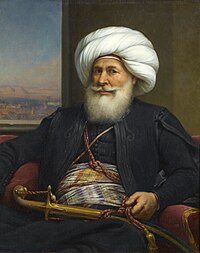 |
|
| An 1840 portrait of Muhammad Ali Pasha by Auguste Couder | |
| 17 May 1805 – 2 March 1848 | |
| محمد علي باشا | |
| Kavalalı Mehmet Ali Paşa | |
| Muhammed Ali Paša | |
| 4 March 1769 | |
| Kavala, Macedonia (present-day Greece) | |
| 2 August 1849 (aged 80) | |
| Ras el-Tin Palace, Alexandria, Egypt | |
| Mosque of Muhammad Ali, Cairo Citadel, Egypt | |
| Ahmad Khurshid Pasha | |
| Ibrahim Pasha | |
| Emina of Nosratli Madouran Ayn al-Hayat Montaz Mahivech Namchaz Ziba Hadidja Chams Safa Shama Nour |
|
| Tevhida Ibrahim Pasha Tusun Pasha Isma'il Hatice (a.k.a. Nazli) Sa'id Pasha Hassan Ali Sadik Bey Muhammad Abdel Halim Muhammad Ali the Younger Fatma al-Ruhiya Zeinab |
|
| Muhammad Ali Dynasty | |
| Ibrahim Agha | |
| Zeinab | |
Muhammad Ali Pasha al-Mas'ud ibn Agha (Arabic: محمد علي باشا) (Mehmet Ali Pasha in Albanian; Muhammed Ali Paša in Bosnian; Kavalalı Mehmet Ali Paşa in Turkish)[2] (4 March 1769 – 2 August 1849) was an Albanian who became Wāli, and self-declared Khedive of Egypt and Sudan. Though not a modern nationalist, he is regarded as the founder of modern Egypt because of the dramatic reforms in the military, economic, and cultural spheres that he instituted. The dynasty that he established would rule Egypt and Sudan until the Egyptian Revolution of 1952
Muhammad or Mehmed
The spelling of Muhammad Ali's first name in both Arabic, and Ottoman Turkish was consistent: محمد (Muhammad). This is the name by which he was known to his Egyptian subjects, and the name used uniformly in Egyptian, and Arab historical scholarship. However, given his original status as a commander in the Ottoman military, his first name is often rendered as Mehmed, or Mehmet, as this was the way in which his name was pronounced by the Turkish-speaking leadership. Current English-language historical scholarship is divided as to which is preferable, with the majority opinion favoring the former. Typically, historians accentuating the Egyptian character of his rule opt for 'Muhammad', whilst those accentuating the Ottoman character opt for 'Mehmed', or 'Mehmet'. This distinction is not an issue for writings in Arabic, but only for those writing in a Latin alphabet.
Early life
Muhammad Ali was born in Kavala, in the Ottoman province of Macedonia (now a part of modern Greece) to Albanian parents.[4][5][6][7][8] According to the many French, English and other western journalists who interviewed him, and according to people who knew him, the only language he knew fluently was Albanian.[9] He learned Arabic only in his adult life.[citation needed] He was also competent in Turkish.[10] The son of a tobacco and shipping merchant named Ibrahim Agha, his mother Zainab Agha was his uncle Husain Agha's daughter. Muhammad Ali was the nephew of the "Ayan of Kavalla" (Çorbaci) Husain Agha. When his father died at a young age, Muhammad was taken and raised by his uncle with his cousins. As a reward for Muhammad Ali's hard work, his uncle Çorbaci gave him the rank of "Bolukbashi" for the collection of taxes in the town of Kavala. After his promising success in collecting taxes, he gained Second Commander rank under his cousin Sarechesme Halil Agha in the Kavala Volunteer Contingent that was sent to re-occupy Egypt following Napoleon's withdrawal. He married Ali Agha's daughter, Emine Nosratli, a wealthy widow of Ali Bey.
In 1801, the Albanian commander of the Ottoman army was sent to re-occupy Egypt following a brief French occupation. He was second in command under his cousin Sarechesme Halil Agha in the Kavala Volunteer Contingent, which was itself part of a larger Ottoman force. The expedition landed at Aboukir in the spring of 1801.[11]
The French withdrawal left a power vacuum in the Ottoman province. Mamluk power had been weakened, but not destroyed, and Ottoman forces clashed with the Mamluks for power.[12] During this period of anarchy Muhammad Ali used his Albanian troops to play both sides, gaining power and prestige for himself.[13] As the conflict drew on, the local populace grew weary of the power struggle. Led by the ulema, a group of prominent Egyptians demanded that the Wāli (governor), Ahmad Kurshid Pasha, step down and Muhammad Ali be installed as the new Wāli in 1805.[13]
The Ottoman Sultan, Selim III, was not in a position to oppose Muhammad Ali’s ascension, thereby allowing Muhammad Ali to set about consolidating his position. During the infighting between the Ottomans and Mamluks between 1801 and 1805, Muhammad Ali had carefully acted to gain the support of the general public.[14] By appearing as the champion of the people Muhammad Ali was able to forestall popular opposition until he had consolidated power.
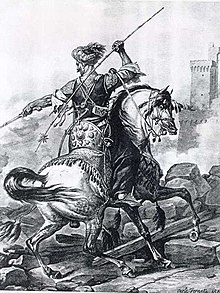
Mamluk cavalryman
The Mamluks still posed the greatest threat to Muhammad Ali. They had controlled Egypt for more than 600 years, and over that time they had extended their rule extensively throughout Egypt. Muhammad Ali’s approach was to eliminate the Mamluk leadership, then move against the rank and file. In 1811, Muhammad Ali invited the Mamluk leaders to a celebration held at the Cairo Citadel in honor of his son, Tusun, who was being appointed to lead a military expedition into Arabia. When the Mamluks arrived, they were trapped and killed.[15] After the leaders were killed, Muhammad Ali dispatched his army throughout Egypt to rout the remainder of the Mamluk forces.
Muhammad Ali transformed Egypt into a regional power which he saw as the natural successor to the decaying Ottoman Empire. He summed up his vision for Egypt as follows:
"I am well aware that the (Ottoman) Empire is heading by the day toward destruction...On her ruins I will build a vast kingdom... up to the Euphrates and the Tigris
Reforming Egypt
Sultan Selim III had recognized the need to reform and modernize the Ottoman Empire along European lines to ensure that his state could compete. Selim III, however, faced stiff local opposition from an entrenched clergy and military apparatus. Consequently, Selim III was deposed and ultimately killed for his efforts. Muhammad Ali, too, recognized the need to modernize, and unlike Selim, he had dispatched his chief rival, giving him a free hand to mimic Selim’s attempted reforms.
Muhammad Ali’s goal was to establish a powerful, European-style state.[17] In order to do that, he had to reorganize Egyptian society, streamline the economy, train a professional bureaucracy, and build a modern military.
His first task was to secure a revenue stream for Egypt. To accomplish this, Muhammad Ali ‘nationalized’ all the land of Egypt, thereby officially owning all the production of the land. He accomplished the state annexation of property by raising taxes on the ‘tax-farmers’ throughout Egypt. The new taxes were intentionally high and when the tax-farmers could not meet the demanded payments, Muhammad Ali confiscated the lands.[18]
In practice, Muhammad Ali’s land reform amounted to a monopoly on trade in Egypt. He required all producers to sell their goods to the state. The state in turn resold Egyptian goods, within Egypt and to foreign markets, and retained the surplus. The practice proved very profitable for Egypt with the cultivation of long staple cotton. The new-found profits also extend down to the individual farmers, as the average wage increased fourfold.[19]
In addition to bolstering the agricultural sector, Muhammad Ali built an industrial base for Egypt. His motivation for doing so was primarily an effort to build a modern military. Consequently, he focused on weapons production. Factories based in Cairo produced muskets and cannons. With a shipyard he built in Alexandria, he began construction of a navy. By the end of the 1830s, Egypt’s war industries had constructed nine 100-gun warships and were turning out 1,600 muskets a month.[20]
However, the industrial innovations were not limited to weapons production. Muhammad Ali established a textile industry in an effort to compete with European industries and produce greater revenues for Egypt. While the textile industry was not successful, the entire endeavor employed tens of thousands of Egyptians.[20] Additionally, by hiring European managers, he was able to introduce industrial training to the Egyptian population. To staff his new industries Muhammad Ali employed a corvée labor system. The peasantry objected to these conscriptions and many ran away from their villages to avoid being taken, sometimes fleeing as far away as Syria. A number of them maimed themselves so as to be unsuitable for combat: common ways of self-maiming were blinding an eye with rat poison and cutting off a finger of the right hand, which usually worked the firing mechanism of a rifle.
Beyond building a functioning, industrial economy, Muhammad Ali also made an effort to train a professional military and bureaucracy. He sent promising citizens to Europe to study. Again the driving force behind the effort was to build a European-style army. Students were sent to study European languages, primarily French, so they could in turn translate military manuals into Arabic. He then used both educated Egyptians and imported European experts to establish schools and hospitals in Egypt. The European education also provided talented Egyptians with a means of social mobility.
A byproduct of Muhammad Ali’s training program was the establishment of a professional bureaucracy. Establishing an efficient central bureaucracy was an essential prerequisite for the success of Muhammad Ali’s other reforms. In the process of destroying the Mamluks, the Wāli had to fill the governmental roles that the Mamluks had previously filled. In doing so, Muhammad Ali kept all central authority for himself. He partitioned Egypt into ten provinces responsible for collecting taxes and maintaining order.[20] Muhammad Ali installed his sons in most key positions; however, his reforms did offer Egyptians opportunities beyond agriculture and industry.
[edit] Cultural impact
In the 1820s, Muhammad Ali sent the first educational "mission" of Egyptian students to Europe. This contact resulted in literature that is considered the dawn of the Arabic literary renaissance, known as the Nahda.
To support the modernization of industry and the military, Muhammad Ali set up a number of schools in various fields where French texts were studied. Rifa'a al-Tahtawi supervised translations from French to Arabic on topics ranging from sociology and history to military technology, and these translations have been considered the second great translation movement, after the first from Greek into Arabic.
In 1835, his government founded the first indigenous press in the Arab World, the Bulaq press. The Bulaq press published the official gazette of Muhammad Ali's government.
[edit] Military campaigns
Though Muhammad Ali’s chief aim was to establish a European-style military, and carve out a personal empire, he waged war initially on behalf of the Ottoman Sultan, Mahmud II, in Arabia, and Greece. Subsequent thereto, he came into open conflict with the Ottoman Empire.
His first military campaign was an expedition into the Arabian Peninsula. The holy cities of Mecca, and Medina had been captured by the House of Saud, who had recently embraced a form of Islam called Wahhabism. Armed with their newfound religious zeal, the Muhammad ibn Saud began conquering parts of Arabia. This Ottoman–Saudi War culminated in the capture of the Hejaz region from the Ottoman Empire in 1803.
With the main Ottoman army tied up in Europe, Mahmud II turned to Muhammad Ali to recapture the Arabian territories. Muhammad Ali in turn appointed his son, Tusun, to lead a military expedition in 1811. The campaign was initially turned back in Arabia; however, a second attack was launched in 1812 that succeeded in recapturing Hejaz.[21]
While the campaign was successful, the power of the Saudis was not broken. They continued to harass Ottoman and Egyptian forces from the central Nejd region of the Peninsula. Consequently, Muhammad Ali dispatched another of his sons, Ibrahim, at the head of another army to finally rout the Saudis. After a two-year campaign, the Saudis were crushed and most of the Saudi family was captured. The family leader, Abdullah ibn Saud, was sent to Istanbul, and executed.[22]
Muhammad Ali next turned his attention to military campaigns independent of the Porte, beginning with Sudan which he viewed as a valuable addition resource of territory, gold, and slaves. Sudan at the time had no real central authority and used primitive weaponry in its tribal infighting. In 1820 Muhammad Ali dispatched an army of 5,000 troops commanded by his third son, Ismail, south into Sudan with the intent of conquering the territory and subjugating it to his authority.[23] Ali's troops made headway into Sudan in 1821, but met with fierce resistance. Ultimately, the superiority of Egyptian troops and firearms ensured the conquest of Sudan. Ali now had an outpost from which he could expand to the source of the Nile in Ethiopia, and Uganda. His administration captured slaves from the Nuba Mountains, and west and south Sudan, all incorporated into a foot regiment known as the Gihadiya (pronounced Jihadiya in non-Egyptian Arabic). Ali's reign in Sudan, and that of his immediate successors, is remembered in Sudan for its brutality and heavy-handedness, contributing to the popular independence struggle of the self-proclaimed Mahdi, Muhammad Ahmad, in 1881.
While Muhammad Ali was expanding his authority into Africa, the Ottoman Empire was being challenged by ethnic rebellions in its European territories. The rebellion in the Greek provinces of the Ottoman Empire began in 1821. The Ottoman army proved ineffectual in its attempts to put down the revolt as ethnic violence spread as far as Constantinople. With his own army proving ineffective, Sultan Mahmud II offered Muhammad Ali the island of Crete in exchange for his support in putting down the revolt.
Muhammed Ali sent 16,000 soldiers, 100 transports, and 63 escort vessels under command of his son, Ibrahim Pasha.[24] Britain, France, and Russia intervened to protect the Greeks. On 20 October 1827 at the Navarino, while under the command of Muharram Bey, the Ottoman representative, the entire Egyptian navy was sunk by the European Allied fleet, under the command of Admiral Edward Codrington (1770-1851). If the Porte was not in the least prepared for this confrontation, Muhammad Ali was even less prepared for the loss of his highly competent, expensively assembled and maintained navy. With its fleet essentially destroyed, Egypt had no way to support its forces in Greece and was forced to withdraw. Ultimately the campaign cost Muhammad Ali his navy and had not yielded any tangible gains.
In compensation for this loss Muhammad Ali asked the Porte for the territory of Syria. The Ottomans were indifferent to the request; the Sultan himself asked blandly what would happen if Syria was given over and Muhammad Ali later deposed.[25] But Muhammad Ali was no longer willing to tolerate Ottoman indifference. To compensate for his, and Egypt's, losses the wheels for the conquest of Syria were set in motion.
Like other rulers of Egypt before him, Ali desired to control Bilad al-Sham (the Levant), both for its strategic value and for its rich natural resources; nor was this a sudden, vindictive decision on the part of the Wāli since he had harbored this goal since his early years as Egypt's unofficial ruler. For not only had Syria abundant natural resources, it also had a thriving international trading community with well developed markets throughout the Levant; in addition, it would be a captive market for the goods now being produced in Egypt. Yet perhaps most of all, Syria was desirable as a buffer state between Egypt and the Ottoman Sultan.
A new fleet was built, a new army was raised and on 31 October 1831, under Ibrahim Pasha, the Egyptian invasion of Syria initiated the First Turko-Egyptian War. For the sake of appearance on the world stage, a pretext for the invasion was vital. Ultimately, the excuse for the expedition was a quarrel with Abdullah Pasha of Acre. The Wāli alleged that 6,000 fellahin had fled to Acre to escape the draft, corvée, and taxes, and he wanted them back.[26] (See also: 1834 Arab revolt in Palestine)
The Egyptians overran Syria easily with little resistance. Acre was captured after a six-month siege, which lasted from 3 November 1831 to 27 May 1832. The Egyptian army marched north into Anatolia. At the Battle of Konya (21 December 1832), Ibrahim Pasha soundly defeated the Ottoman army led by the sadr azam Grand Vizier Reshid Pasha. There were now no military obstacles between Ibrahim's forces and Constantinople itself.
Through the course of the campaign Muhammad Ali paid particular focus to the European powers. Fearing another intervention that would reverse all his gains, he proceeded slowly and cautiously. For example, Muhammad Ali continued the practice of using the sultan’s name at Friday prayers in the newly captured territories and continued to circulate Ottoman coins instead of issuing new ones bearing his likeness.[27] So long as Muhammad Ali’s march did not threaten to cause the complete collapse of the Ottoman state, the powers in Europe remained as passive observers.[28]
Despite this show, Muhammad Ali's goal was now to remove the current Ottoman Sultan Mahmud II and replace him with the sultan's son, the infant Abdülmecid. This possibility so alarmed Mahmud II that he accepted Russia's offer of military aid resulting in the Treaty of Hünkâr İskelesi.[29] Russia's gain dismayed the British and French governments, resulting in their direct intervention. From this position, the European powers brokered a negotiated solution in May 1833 known as the Convention of Kutahya.[30]. The terms of the peace were that Ali would withdraw his forces from Anatolia and receive the territories of Crete (then known as Candia) and the Hijaz as compensation, and Ibrahim Pasha would be appointed Wāli of Syria. The peace agreement fell short, however, of granting Muhammad Ali an independent kingdom for himself, leaving him wanting.[31]
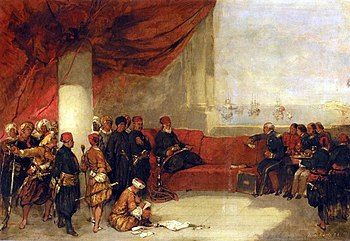
Interview with Mehmet Ali in his Palace at Alexandria (1839) by David Roberts
Sensing that Muhammad Ali was not content with his gains, the sultan attempted to preempt further action against the Ottoman Empire by offering him hereditary rule in Egypt and Arabia if he withdrew from Syria and Crete and renounced any desire for full independence.[32] Muhammad Ali rejected the offer, knowing that Mahmud could not force the Egyptian presence from Syria and Crete.
On 25 May 1838, Muhammad Ali informed Britain, and France that he intended to declare independence from the Ottoman Empire.[33] This action was contrary to the desire of the European powers to maintain the status quo within the Ottoman Empire.[32] With Muhammad Ali’s intentions clear, the European powers, particularly Russia, attempted to moderate the situation and prevent conflict. Within the Empire, however, both sides were gearing for war. Ibrahim already had a sizable force in Syria. In Constantinople, the Ottoman commander, Hafiz Pasha, assured the Sultan that he could defeat the Egyptian army.
When Mahmud II ordered his forces to advance on the Syrian frontier, Ibrahim attacked and destroyed them at the Battle of Nezib (24 June 1839) near Urfa. In an echo of the Battle of Konya, Constantinople was again left vulnerable to Ali's forces. A further blow to the Ottomans was the defection of their fleet to Muhammad Ali.[32] Mahmud II died almost immediately after the battle took place and was succeeded by sixteen-year-old Abdülmecid. At this point, Ali and Ibrahim began to argue about which course to follow; Ibrahim favored conquering the Ottoman capital and demanding the imperial seat while Muhammad Ali was inclined simply to demand numerous concessions of territory and political autonomy for himself and his family.
At this point the European powers again intervened (see Oriental Crisis of 1840). On 15 July 1840, the British Government, which had colluded with the Austro-Hungarian Empire, Prussia, and Russia to sign the Convention of London, offered Muhammad Ali hereditary rule of Egypt as part of the Ottoman Empire if he withdrew from the Syrian hinterland and the coastal regions of Mount Lebanon. Muhammad Ali hesitated, believing he had support from France. His hesitation proved costly; when French support failed to materialize, British naval forces moved against Syria, and Alexandria.[34] In the face of European military might, Muhammad Ali acquiesced.
After the British, and Austrian navies blockaded the Nile delta coastline, shelled Beirut (11 September 1840), and after Acre had capitulated (3 November 1840), Muhammad Ali agreed to the terms of the Convention on 27 November 1840. These terms included renouncing his claims over Crete, and Hejaz and downsizing his navy, and his standing army to 18,000 men, provided that he and his descendants would enjoy hereditary rule over Egypt and Sudan — an unheard-of status for an Ottoman viceroy.[35]
Final years

The Mosque of Muhammad Ali in Cairo, Egypt
After 1843, fast on the heels of the Syrian débâcle and the treaty of Balta Liman, which forced Egypt to tear down its import barriers and the government to give up its monopolies, Muhammad Ali's mind became increasingly clouded and tended towards paranoia. Whether it was genuine senility or the effects of the silver nitrate he had been given years before to treat an attack of dysentery remains a subject of debate.[36]
In 1844 the tax receipts were in and Sherif Pasha, the head of the diwan al-maliyya (financial ministry), was too fearful for his life to tell the Wāli the news that Egyptian debt now stood at 80 million francs (£2,400,000). Tax arrears came to 14,081,500 piastres[37] out of a total estimated tax of 75,227,500 pts.[38] Timidly he approached Ibrahim Pasha with these facts, and together came up with a report and a plan. Anticipating his father's initial reaction, İbrahim arranged for Muhammad Ali's favorite daughter to break the news. It did little, if any, good. The resulting rage was far beyond what any had been expected, and it took six full days for a tenuous peace to take hold.
A year later while Ibrahim, progressively crippled by rheumatic pains and tuberculosis (he was beginning to cough up blood), was sent to Italy to take the waters, Muhammad Ali, in 1846, traveled to Constantinople. There he approached the Sultan, expressed his fears, and made his peace, explaining: "[My son] Ibrahim is old and sick, [my grandson] Abbas is indolent (happa), and then children will rule Egypt. How will they keep Egypt?"[39] After he secured hereditary rule for his family, the Wali ruled until 1848, when senility made further governance by him impossible.

Tomb of Muhammad Ali in Alabaster Mosque in Cairo
It soon came to the point where his son and heir, the mortally ailing Ibrahim, had no choice but to travel to Constantinople and request that the Sultan recognize him ruler of Egypt and Sudan even though his father was still alive. However, on the ship returning home, Ibrahim, gripped by fever and guilt, succumbed to seizures and hallucinations. He survived the journey but within six months was dead. He was succeeded by his nephew (Tosun's son) Abbas I.
By this time Muhammad Ali had become so ill and senile that he was not informed of his son's death. Lingering a few months more, Muhammad Ali died at Ras el-Tin Palace in Alexandria on 2 August 1849, and ultimately was buried in the imposing mosque he had commissioned in the Citadel of Cairo.
But the immediate reaction to his death was noticeably low key, thanks in no small part to the contempt the new wāli Abbas Pasha had always felt towards his grandfather.
Eye-witness British council John Murray wrote:
... the ceremonial of the funeral was a most meagre,
miserable affair;
the [diplomatic] Consular was not invited to attend,
and neither the shops nor the Public offices were closed --
in short, a general impression prevails that Abbas
Pasha has shown a culpable lack of
respect for the memory of his illustrious grandfather,
in allowing his obsequies to be conducted in
so paltry a manner, and in neglecting
at attend them in person. ...[the]
attachment and veneration of all classes in Egypt for
the name of Muhammad Ali are prouder
obsequies than any of which it was in power of
his successor to confer.
The old inhabitants remember
and talk of the chaos and anarchy from which
he rescued this country
; the younger compare
his energetic rule with the capricious,
vacillating government of his successor;
all classes whether Turk, or Arab, not only feel,
but do not hesitate to say openly that the prosperity
of Egypt has died with Muhammad Ali...
In truth my Lord,
it cannot be denied, that Muhammad Ali,
notwithstanding all his faults was a great man.
· Order of the August Portrait of Ottoman Empire
· Order of Glory, 1st Class of Ottoman Empire
· Grand Cross of the Legion d'Honneur of France
... the ceremonial of the funeral was a most meagre,
miserable affair;
the [diplomatic] Consular was not invited to attend,
and neither the shops nor the Public offices were closed --
in short, a general impression prevails that Abbas
Pasha has shown a culpable lack of
respect for the memory of his illustrious grandfather,
in allowing his obsequies to be conducted in
so paltry a manner, and in neglecting
at attend them in person. ...[the]
attachment and veneration of all classes in Egypt for
the name of Muhammad Ali are prouder
obsequies than any of which it was in power of
his successor to confer.
The old inhabitants remember
and talk of the chaos and anarchy from which
he rescued this country
; the younger compare
his energetic rule with the capricious,
vacillating government of his successor;
all classes whether Turk, or Arab, not only feel,
but do not hesitate to say openly that the prosperity
of Egypt has died with Muhammad Ali...
In truth my Lord,
it cannot be denied, that Muhammad Ali,
notwithstanding all his faults was a great man.
· Order of the August Portrait of Ottoman Empire
· Order of Glory, 1st Class of Ottoman Empire
· Grand Cross of the Legion d'Honneur of France
The prevailing historical view of Muhammad Ali is as the ‘Father of Modern Egypt', being the first ruler since the Ottoman conquest in 1517 to permanently divest the Porte of its power in Egypt. While failing to achieve formal independence for Egypt during his lifetime, he was successful in laying the foundation for a modern Egyptian state. In the process of building an army to defend and expand his realm, he built a central bureaucracy, an educational system that allowed for social mobility, and an economic base that included an agricultural cash crop, cotton, and military-based manufacturing. His efforts established his progeny as the rulers of Egypt and Sudan for nearly 150 years and, rendered Egypt a de facto independent state[41].
Others, however, view him not as a builder, but rather as a conqueror. Of Albanian rather than Egyptian origin, throughout his reign Turkish rather than Arabic was the official language of his court. Some argue that he exploited Egyptian manpower and resources for his own personal ends, not Egyptian national ones, with the manpower requirements that he placed on Egyptians being particularly onerous. Taken together in this light, Muhammad Ali is cast by some as another in a long line of foreign conquerors dating back to the Persian occupation in 525 B.C.[42]. This view, however, is at odds with the majority opinion of Egyptian, and Arab historians, and Egyptian public opinion





